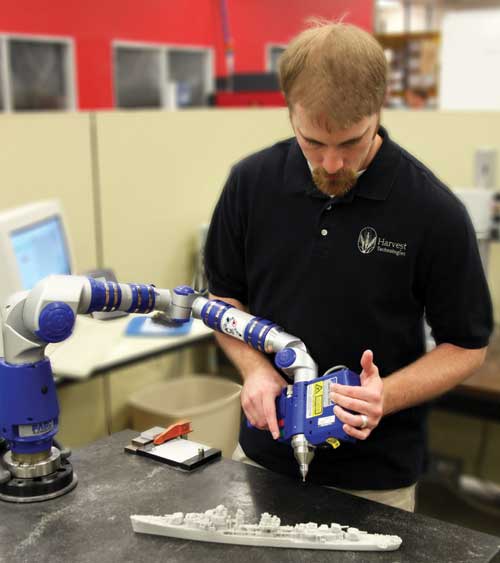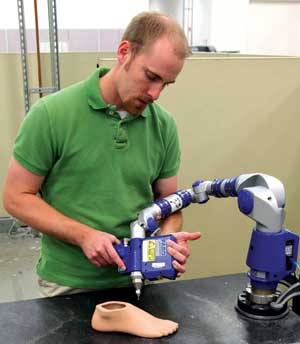Fast App: Laser Scanning Advances Rapid Prototyping, Manufacturing
Harvest Technologies uses laser scanners to expedite additive manufacturing and ensure that their complex prototypes conform to CAD designs.
Latest News
September 14, 2011
By Greg Richards
Generally speaking, engineers are pragmatists. Find the best way to complete your task accurately, quickly and easily (or easily enough), and then run with it. Many have used laser technologies for years, to expedite and improve everything from cutting to measuring. These days, a growing number of engineers are using laser scanners to help create prototypes for new products and ensure their conformity to original CAD designs “and they’re doing so more quickly and accurately than ever before.
Case in Point Recently, Harvest Technologies was tasked with performing the dimensional inspection of a prosthetic foot prototype by one of its customers. The human foot is very curvy, with rounded ends that make it difficult to obtain traditional XYZ measurements.
Utilizing their arm, Harvest engineers were able to perform a complete inspection across multiple dimensions. This allowed them to not only check length, width and height of the prototype, but also several other critical dimensions. “With something as complex as a prosthetic, where appearance is very important, having this ability ultimately gave us the chance to produce a product that was as realistic as it could possibly be,” says Lewis Simms, marketing and business development representative for Harvest Technologies. “We were able to cover everything “from the size of the toes to the curvature of the heel.” ” G.R. |
In the process known as additive manufacturing (AM), which encompasses both rapid prototyping and direct manufacturing, complex 3D objects are created in a short period of time. Think days rather than weeks. There are many ways to produce and form the deliverable:
- Stereolithography (SL) uses a UV laser to photo-cure epoxy-based resins and grow objects, layer by layer, from 3D electronic data.
- Similar to SL, laser sintering (LS) also builds prototypes in layers, but instead uses a carbon dioxide laser to fuse myriad thermoplastic and metal powders to generate a finished product.
- Other processes, like computed numerically controlled (CNC) machining, are used to whittle down solid blocks of material to arrive at a finished part quickly and inexpensively.
At the end of the day, though, even prototypes produced by the most accurate and advanced methods need to be measured and checked against CAD designs to ensure accuracy for the customer.
Enter Laser-scanning Technology
Harvest Technologies is an AM firm located in Belton, TX. Formed by father and son David E. and David K. Leigh, the firm has been engineering prototypes and production parts for customers around the world since 1995. The Harvest team had mastered the techniques involved with rapid prototyping, but sought a way to improve the speed and accuracy with which they checked and ensured the finished products.
Referred by one of their customers, they contacted Lake Mary, FL-based FARO Technologies about its FARO Laser ScanArm to help them in their task. Laser scanners like the one FARO provided offer the ability to capture both high-end and fine surface measurements for use in SL and other files. Where calipers sufficed in capturing the measurements on simple box dimensions, the Laser ScanArm captures up to 19,200 points per second “and could be used to measure complex parts.
A 3D laser scanner’s technology is simple, and then again, it isn’t. A scanner like the one used by Harvest attaches to a portable coordinate measuring machine (CMM), which in this case was a FaroArm Platinum. The device then projects a laser line on the subject and uses a camera to look for the location of the laser line silhouette. Depending on how far away the laser strikes a surface, each point on the laser line profile appears at different places in the camera’s field of view. Data is collected one “slice,” or cross-section, at a time and triangulated.

Laser scanners like the ScanArm enable the rapid scanning of complex
models, such as a battleship.
The CMM acts as a referencing device, or “localizer,” that tracks and communicates to the host application software the position of each cross-section in space. As the laser stripe is swept across an object, hundreds of cross-sections are instantly captured and rendered collectively in a CAD environment. The end result is a full 3D digital representation of the object.
Harvest Technologies now uses Geomagic software to place its completed prototype scans into CAD files. The scanned prototypes are then compared to an original 3D model. Tolerances in this line of work are tight, so Harvest’s ability to transform an existing part into a digital representation “and remove the human error element from CAD-to-part inspections “is a big advantage.
By using laser-scanning technology, Harvest Technologies creates and checks products in less time, more cost effectively, and without much of the waste that comes with introducing the human element to measurement practices. Perhaps most importantly, errors in a prototype are caught early, before the product is passed along to the customer or valuable material is wasted on a flawed production run.
Or as Harvest’s SL Production Manager Jason Morgan puts it, the ScanArm is “well worth its weight in gold.”
Richards is the public relations and events supervisor for FARO Technologies.
Subscribe to our FREE magazine, FREE email newsletters or both!
Latest News
About the Author
DE’s editors contribute news and new product announcements to Digital Engineering.
Press releases may be sent to them via [email protected].







